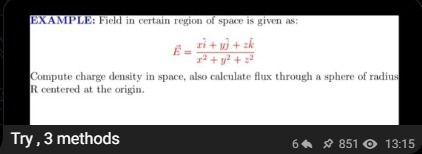Question
Question: Field in certain region of space is given as: $\vec{E} = \frac{x\hat{i} + y\hat{j} + z\hat{k}}{x^2 ...
Field in certain region of space is given as:
E=x2+y2+z2xi^+yj^+zk^
Compute charge density in space, also calculate flux through a sphere of radius R centered at the origin.

Charge Density: ρ=r2ϵ0
Flux through a sphere of radius R: ΦE=4πR
Solution
Solution
- Finding the Charge Density
The electric field is given by
E=x2+y2+z2xi^+yj^+zk^.In spherical coordinates, where r=x2+y2+z2 and r^=rxi^+yj^+zk^, the field becomes
E=r2rr^=rr^.For a radial field E=f(r)r^, the divergence in spherical coordinates is
∇⋅E=r21drd[r2f(r)].Here, f(r)=r1 so that
r2f(r)=r2⋅r1=r.Differentiating,
drd(r)=1.Thus,
∇⋅E=r21.By Gauss's law in differential form,
∇⋅E=ϵ0ρ,hence the charge density is
ρ=ϵ0∇⋅E=r2ϵ0.- Calculating the Flux Through a Sphere of Radius R
The total electric flux through a closed surface is
ΦE=∮E⋅dA.For a sphere of radius R, the outward area element is
dA=r^R2sinθdθdϕ.Since E=Rr^ on the surface of the sphere, the dot product becomes
E⋅dA=R1R2sinθdθdϕ=Rsinθdθdϕ.Integrating over the entire sphere:
ΦE=R∫02πdϕ∫0πsinθdθ=R⋅(2π)⋅(2)=4πR.Explanation (Minimal Core Steps):
- Rewrite the field in spherical coordinates: E=r^/r.
- Use ∇⋅E=r21drd(r2⋅(1/r))=r21.
- Apply Gauss’s law: ρ=ϵ0(1/r2).
- Flux through a sphere: Φ=E(R)⋅4πR2=R1⋅4πR2=4πR.
